child restraint MERCEDES-BENZ E-CLASS CABRIOLET 2010 Owners Manual
[x] Cancel search | Manufacturer: MERCEDES-BENZ, Model Year: 2010, Model line: E-CLASS CABRIOLET, Model: MERCEDES-BENZ E-CLASS CABRIOLET 2010Pages: 333, PDF Size: 7.64 MB
Page 9 of 333
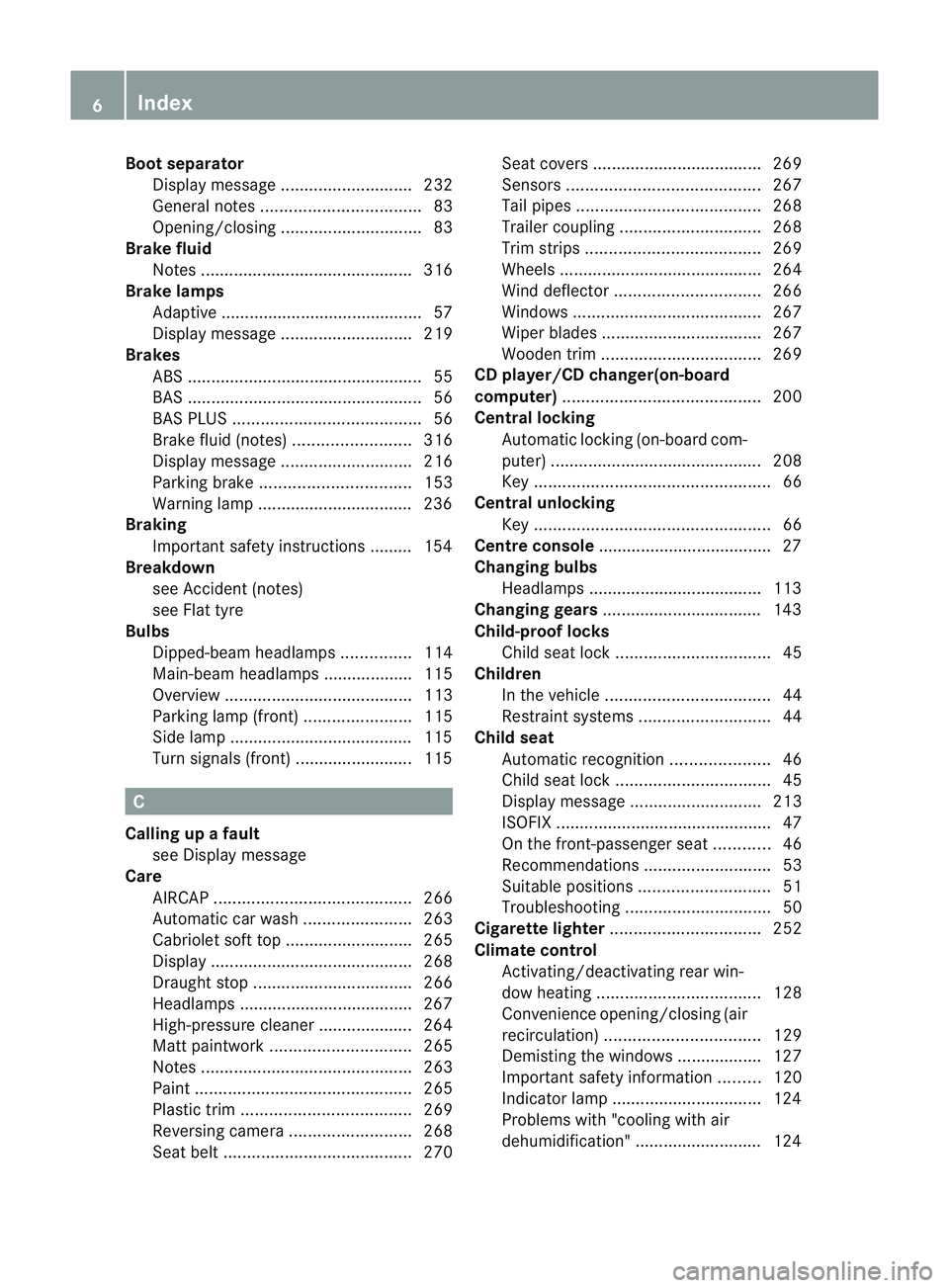
Boo
tseparator
Dis play message ............................ 232
Gen eral notes .................................. 83
Opening/closing .............................. 83
Brake fluid
Note s............................................. 316
Brake lamps
Ada ptive .......................................... .57
Display message ............................ 219
Brakes
ABS .................................................. 55
BAS .................................................. 56
BAS PLUS ........................................ 56
Brake fluid (notes )......................... 316
Display message ............................ 216
Parking brake ................................ 153
Warn ingl am p................................. 236
Braking
Important safety instructions ......... 154
Breakdown
seeA ccident (notes)
se eF lat tyre
Bulbs
Dipped-bea mheadlamps ............... 114
Ma in-beam headlamps ................... 115
Overview ........................................ 113
Parking lamp (front) .......................115
Sid elam p....................................... 115
Turn signals (front) ......................... 115 C
Calling up afault
se eD isplay message
Care
AIRCAP.......................................... 266
Automatic car wash .......................263
Cabri olet soft top ........................... 265
Display ........................................... 268
Draught stop .................................. 266
Hea dlam ps ...... ............................... 267
High-press urec leaner .................... 264
Matt paintwork .............................. 265
Note s............................................. 263
Pa int. ............................................. 265
Pl ast ic trim .................................... 269
Revers ingc amera .......................... 268
Sea tbelt. ....................................... 270Sea
tcover s.................................... 269
Sensors ......................................... 267
Ta il pipe s....................................... 268
Traile rcoupling .............................. 268
Tri ms trips ..................................... 269
Wheels ........................................... 264
Wind deflecto r............................... 266
Windows ........................................ 267
Wi perb lades .................................. 267
Wooden trim .................................. 269
CD player/C Dchanger( on-board
computer) .......................................... 200
Central locking Automatic lockin g(on-board com-
puter) ............................................ .208
Key .................................................. 66
Central unl ocking
Key .................................................. 66
Centr econsole ..................................... 27
Changing bulbs Headlamps ..................................... 113
Changing gears .................................. 143
Child-proof locks Child se at lock................................. 45
Children
In the veh icle ................................... 44
Restraint sy stems ............................ 44
Child seat
Automatic recognitio n..................... 46
Ch ilds eat lock ................................. 45
Display message ............................ 213
ISOFIX .............................................. 47
On the front-passenger se at............ 46
Rec ommend ations ........................... 53
Suit able positions ............................ 51
Tro ubleshoot ing............................... 50
Cigarette li ghter ................................ 252
Climate control Activating/deactivating rear win-
dowh eating ................................... 128
Convenience opening/closing (air
recirculation) ................................. 129
Demist ingt he windows ...... ............ 127
Important safety information .........120
Indicator lamp ................................ 124
Pro blem swith" cooling with air
deh umidificat ion"........................... 124 6
Index BA 207 ECE ÄJ 2010/1a; 1; 2, en-GB
mkalafa
Version: 3.0.2.11 2010-01-26T13:03:22+01:00-Seite 6
Page 13 of 333
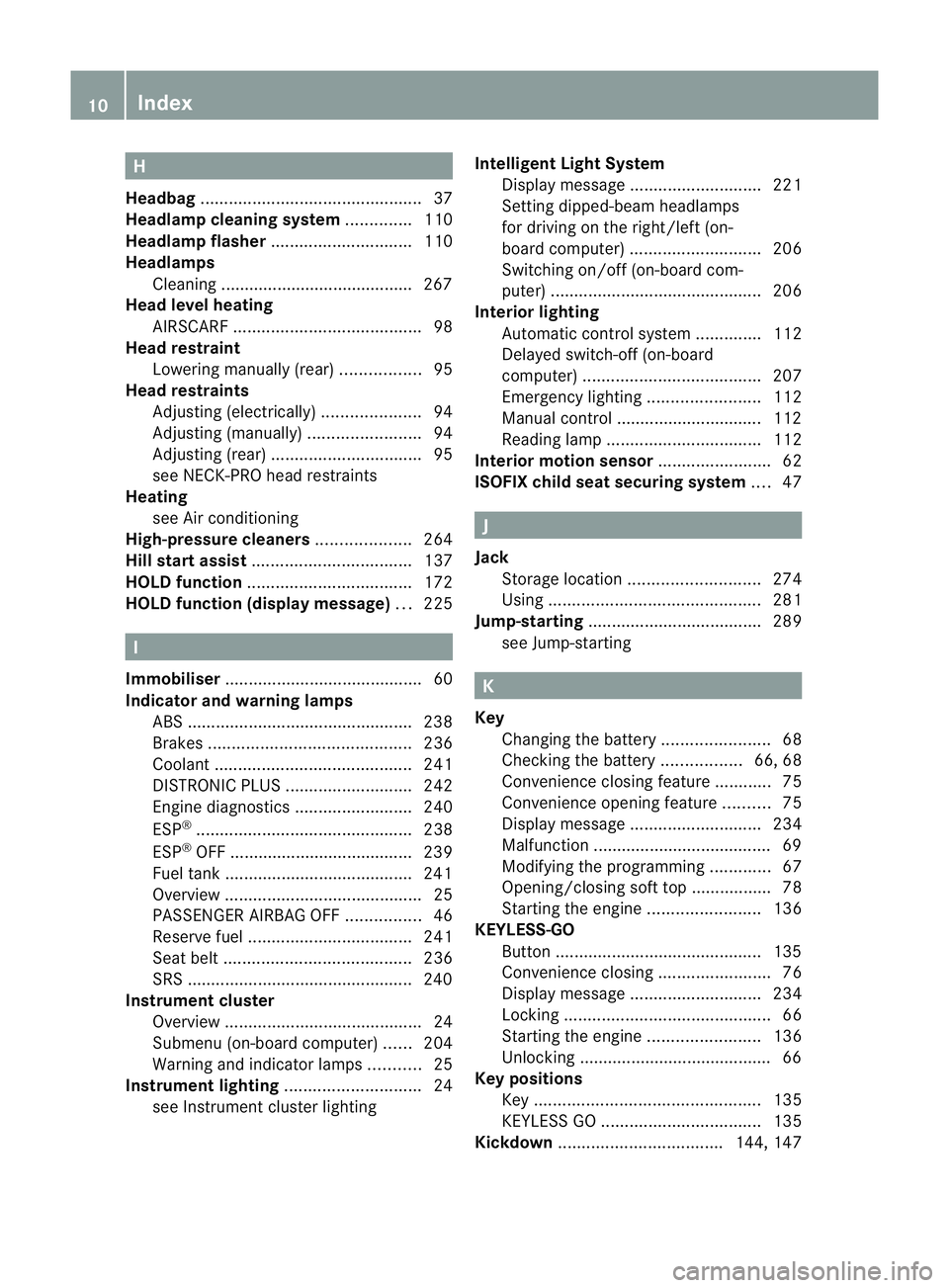
H
Headbag ............................................... 37
Headlamp clean ings yst em .............. 110
Headlamp flasher .............................. 110
Headlamps Clean ing. ........................................ 267
Head level heating
AIRSCAR F........................................ 98
Head restraint
Lowering manually (re ar)................. 95
Head restraints
Adjusting (e lectrically )..................... 94
Adjusting (manually )........................ 94
Adjusting (re ar)................................ 95
se eN ECK-PR Ohead restraints
Hea ting
see Air conditioning
High-pressu recleaners .................... 264
Hill star tassist .................................. 137
HOLD function ................................... 172
HOLD functio n(display message) ...225 I
Immobili ser.......................................... 60
Ind icator and warn ingl amps
ABS ................................................ 238
Brake s........................................... 236
Co olan t.......................................... 241
DISTRONI CPLUS ........................... 242
Engine di agnostics ......................... 240
ESP ®
.............................................. 238
ESP ®
OFF ....................................... 239
Fue ltank ........................................ 241
Overview .......................................... 25
PASSENGER AIRBAG OFF ................46
Reserve fuel ................................... 241
Sea tbelt. ....................................... 236
SRS ................................................ 240
Instrument cluster
Overview .......................................... 24
Submenu (on-bo ardc omputer )...... 204
Warn inga nd indicator lamps ...........25
Instrument li ghting ............................. 24
se eI nstrument cluster lighting Intelligen
tLight System
Display message ............................ 221
Setting di pped-beam headlamps
for driving on the right/left (on-
board computer) ............................ 206
Switch ingo n/off (on-board com-
puter) ............................................. 206
Int erior lighting
Automatic control system ..............112
Del ayed swit ch-off (on-bo ard
computer) ...................................... 207
Emergency lighting ........................112
Manual control ............................... 112
Reading lamp ................................. 112
Int erior motion sensor ........................62
IS OFIX child seat securing system ....47 J
Jack Storage locatio n............................ 274
Using ............................................. 281
Jump-starting ..................................... 289
se eJ ump-st arting K
Key Changing the battery .......................68
Ch ecking the battery .................66, 68
Convenience closing feat ure. ........... 75
Convenience op ening feature ..........75
Display message ............................ 234
Ma lfunction ...... ................................ 69
Modifying the programming .............67
Opening/closing soft top .................78
Starting the engine ........................136
KEYLES S-GO
Button ............................................ 135
Convenience closing ........................76
Display message ............................ 234
Locking ............................................ 66
Starting the engine ........................136
Unlockin g......................................... 66
Ke yp ositions
Key ................................................ 135
KEYLESS GO .................................. 135
Kickdown ................................... 144, 14710
Index BA 207 ECE ÄJ 2010/1a; 1; 2, en-GB
mkalafa
Version: 3.0.2.11 2010-01-26T13:03:22+01:00-Seite 10
Page 15 of 333

Menu (on-boar
dcomputer )............ 200
Transmission output (maximum ).... 311
Mobile telephone
seeM obile phone .......................... 254
Modifying the programming
Key .................................................. 67
MOExtende drun-flat system ...........284
MP3 Operating (on-bo ardc omputer )..... 200
se es eparat eoperating instructions
Multicontour seat ................................ 96
Multifuncti ondisplay ........................ 194
Multifuncti onsteering wheel
Operating the on-board computer .193
Overview .......................................... 26N
Navigation On-bo ardc omputer ....................... 198
se es eparat eoperating instructions
Neck level heating
see AIRSCARF
NECK-PRO hea drestraints
Operation ........................................ .39
Resetting after being triggered ........40
Note sonr unnin ginan ew vehicle ..134 O
Occupant safety Children in the vehicle .....................44
Important safety gu idelines ............. 32
Octan enumbe r(fuel) ........................ 314
Odometer ........................................... 197
Oil seeE ngine oil
On-b oard computer
Assistance menu ........................... 202
Aud iomen u................................... 199
Convenience su bmenu .................. 208
Display message s.......................... 210
Factory settings ............................. 209
Important safety notes ..................192
Instrumen tcluster submenu ..........204
Lig ht subm enu............................... 205
Menu overview .............................. 196
Mess agem emor y.......................... 210Navigation menu
............................ 198
Operating the TV ............................ 200
Operating vid eoDVD ..................... 200
Operatio n....................................... 193
Service menu ................................. 204
Setting smenu ............................... 204
Standard di splays ubmenu ............ 197
Te lephon emenu ............................ 200
Time/Date su bmenu ..................... 205
Tri pm enu ...................................... 197
Veh icle submenu ........................... 207
Operatin gsyst em
se eO n-board computer
Outside temperature
Disp lay. .......................................... 193
Ov erhead control panel
Overview .......................................... 29
Ov erride feature
Rea rside windows ........................... 54 P
Pai nt code .......................................... 312
Pai ntwork (cleaning instructions) ...265
Pan orama sl iding sunroof
Opening/closing .............................. 88
Rain closing feat ure. ........................ 88
Resetting ......................................... 89
Park Assist
Parking Guid ance ........................... 177
Parking ............................................... 153
Parking aid PARKTRONIC ................................. 174
Revers ingc amera .......................... 180
Parking brake .................................... 153
Parking Guidan ce.............................. 177
Display message ............................ 226
Traile rtowing ................................. 180
Parking lamp (di splay message) ......220
Parking lock Releasing manually (automatic
transmission) ................................. 148
Parking pos ition
Exterior mirror on the front-
passenger sid e............................... 102
PARKTRONIC ...................................... 174
Activating/deactivating .................176
Ma lfunction ...... ............................. .177 12
Index BA 207 ECE ÄJ 2010/1a; 1; 2, en-GB
mkalafa
Version: 3.0.2.11 2010-01-26T13:03:22+01:00-Seite 12
Page 17 of 333
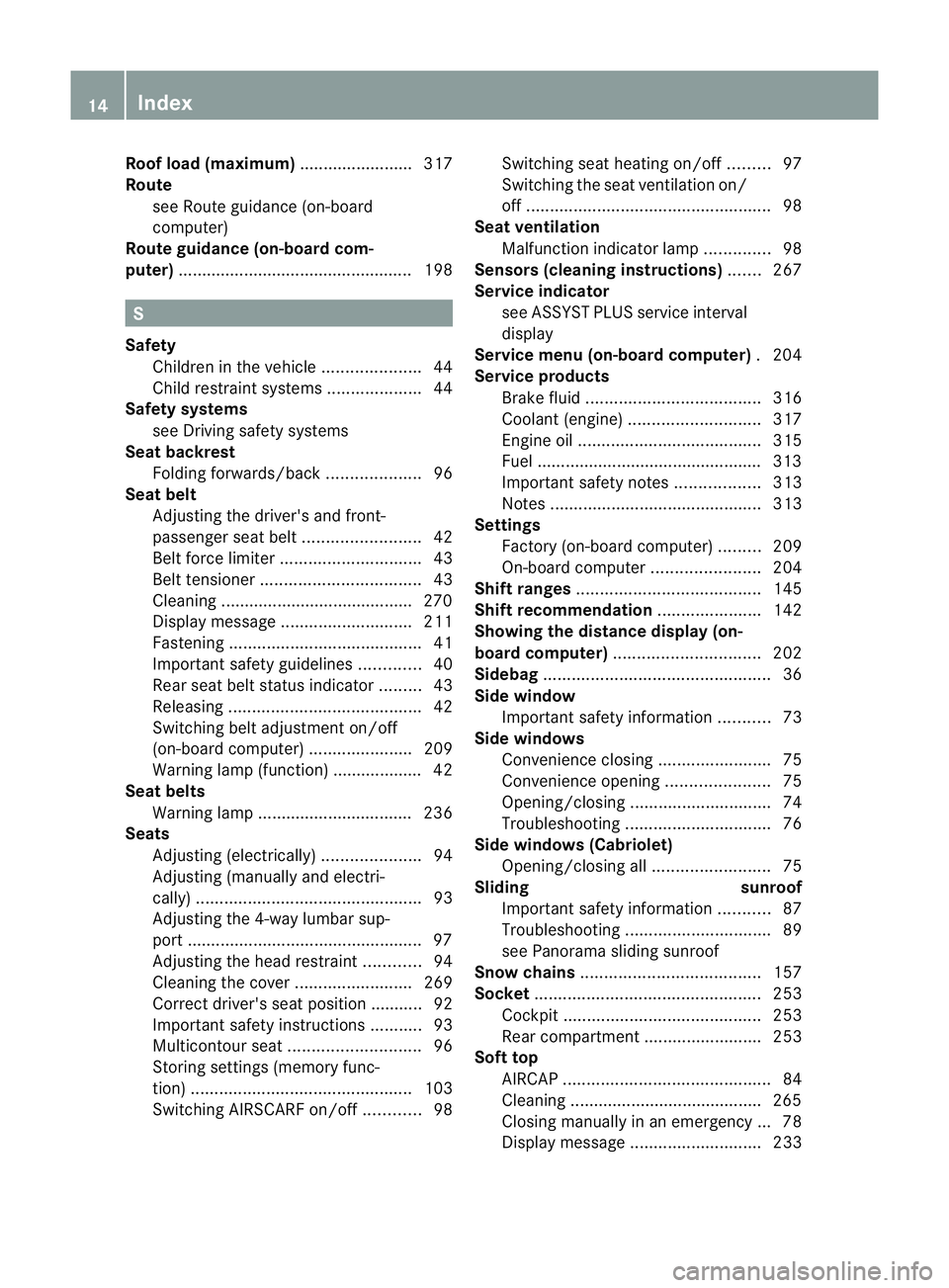
Roo
floa d( maximum) ........................ 317
Route seeR oute guidance (on-board
computer)
Route guidance (on-board com-
puter) ................................................. .198 S
Safety Children in the vehicle .....................44
Ch ildr estra ints ystems .................... 44
Safety systems
seeD riving safety sy stems
Seat backrest
Folding forwards/back ....................96
Seat be lt
Adjusting the driver's and front-
passenger sea tbelt ......................... 42
Bel tforc elimiter .............................. 43
Bel ttensioner .................................. 43
Clean ing. ........................................ 270
Disp laym essage ............................ 211
Fasten ing. ........................................ 41
Important safety gu idelines ............. 40
Rea rseat belt status indicator .........43
Releasing ......................................... 42
Switch ingb elta djustment on/off
(on-board computer) ......................209
Warn ingl am p(function) ................... 42
Seat be lts
Warn ingl am p................................. 236
Seats
Adjusting (electrically )..................... 94
Adjusting (manually and el ectri-
cally) ................................................ 93
Adjusting the 4-way lumba rsup-
port .................................................. 97
Adjusting the head restraint............ 94
Clean ingt he cover ......................... 269
Correct driver's se at position ........... 92
Important safety instructions ...........93
Mu lticontour sea t............................ 96
Storing settings (memory func-
tion) ............................................... 103
Switch ingA IRSCAR Fon/off ............ 98Switch
ings eat heating on/off .........97
Switch ingt he seat ventilation on/
off .................................................... 98
Seat ve ntilation
Malfunction indicator lamp ..............98
Se nsors (cleaning instructions) .......267
Service indicator seeA SSYST PLUS service interval
display
Serv icem enu (on-board computer) .204
Service products Brake fluid ..................................... 316
Co olan t(engine) ............................ 317
Engine oi l....................................... 315
Fue l................................................ 313
Important safety note s.................. 313
Note s............................................. 313
Settings
Factory (on-bo ardc omputer )......... 209
On-bo ardc omputer ....................... 204
Shift rang es....................................... 145
Shift rec ommendation ...................... 142
Sho wing th edistance displa y(on-
bo ard computer) ............................... 202
Sidebag ................................................ 36
Side window Important safety informatio n........... 73
Side windo ws
Convenience closing ........................75
Convenience opening ......................75
Opening/closing .............................. 74
Tro ubleshoot ing............................... 76
Side windo ws(Cabriolet)
Opening/closing al l......................... 75
Sl iding sunroof
Important safety information ...........87
Tro ubleshoot ing............................... 89
se eP anorama sliding sunroof
Sno wchains ...................................... 157
So cket ................................................ 253
Cockpi t.......................................... 253
Rea rcompartmen t......................... 253
Soft top
AIRCAP ............................................ 84
Clean ing. ........................................ 265
Closing manually in an emergency ... 78
Disp laym essage ............................ 23314
Index BA 207 ECE ÄJ 2010/1a; 1; 2, en-GB
mkalafa
Version: 3.0.2.11 2010-01-26T13:03:22+01:00-Seite 14
Page 37 of 333
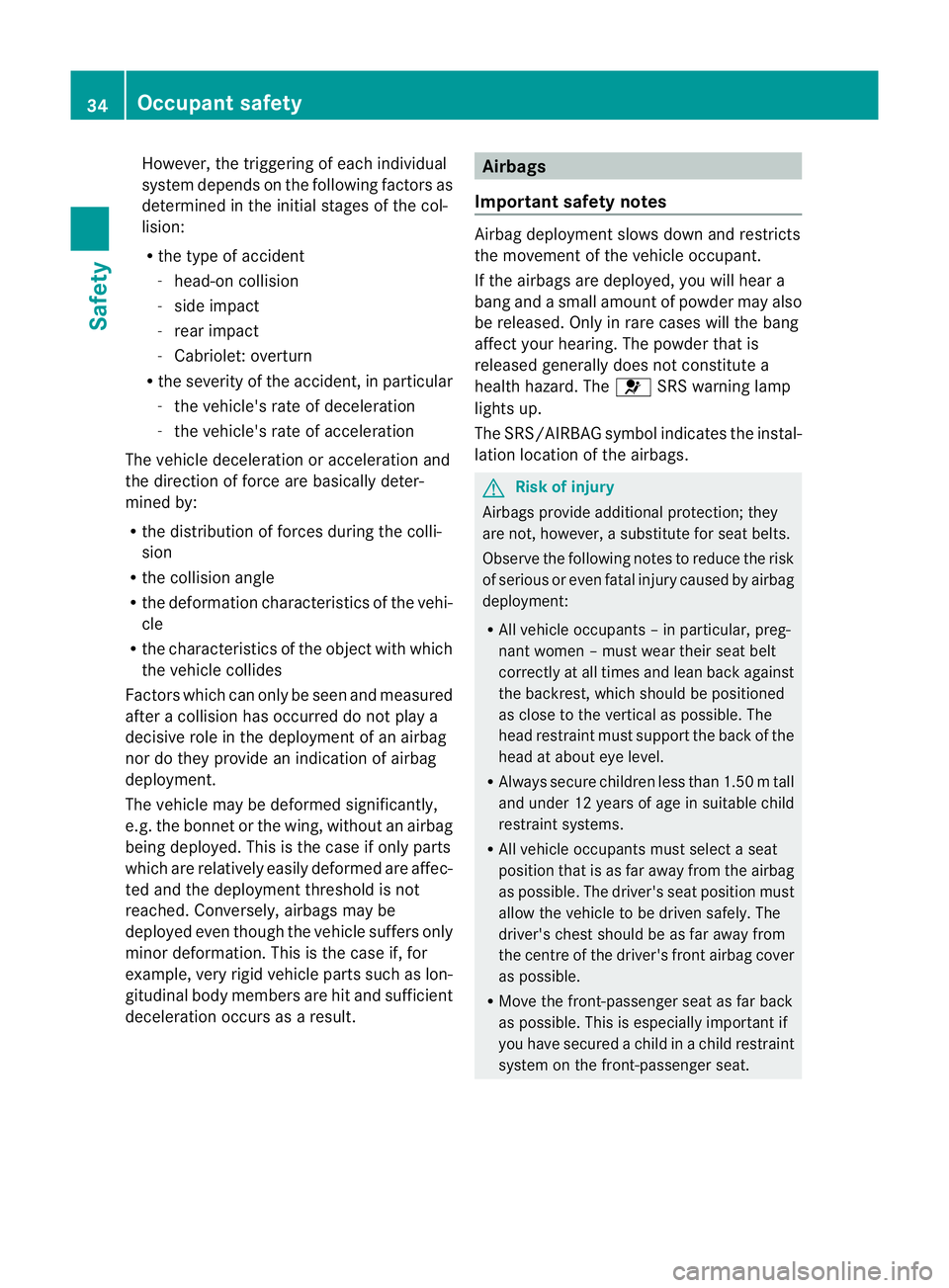
However, the trig
gering of each ind ividual
system depends on the following factors as
determined in the initial stages of the col-
lision:
R the type of accident
- head-on collision
- sid eimpact
- rea rimpact
- Cabriolet: overturn
R thes everity of the accident, in particular
- the vehicle's rat eofdeceleration
- the vehicle's rat eofacceleration
Th ev ehicle deceleration or acceleration and
the direction of force ar ebasicall ydeter-
min edby:
R the distri bution of force sduring the colli-
sion
R the collision angle
R the deform ation characteristics of the vehi-
cle
R the characteristics of the object with which
the vehicle collides
Factors which can only be see nand measured
after acollision has occ urreddon ot play a
decisive role in the deployment of an airbag
nor do they provid eanindicatio nofairbag
deployment.
The vehicle may be deformed significantly,
e.g. the bonnet or the wing, withou tanairbag
being deployed. This is the case if only parts
which are relatively easily deformed are affec-
ted and the deploymen tthreshol disnot
reached. Conversely ,airbags may be
deployed even though the vehicle suffer sonly
minor deformation. Thi sisthe case if, for
example, ver yrigid vehicle parts such as lon-
gitudinal body member sare hi tand sufficient
deceleratio noccurs as aresult. Airbags
Important safety notes Airbag deployment slows down and restricts
the movemen
tofthe vehicle occupant.
If the airbags ar edeployed, you will hear a
bang and asmall amount of powder may also
be released. Only in rare cases will th ebang
affect your hearing. The powde rthat is
released generally does not constitute a
healt hhazard. The 6SRS warning lamp
lights up.
The SRS/AIRBAG symbol indicates the instal-
lation location of the airbags. G
Risk of injury
Airbags provide additional protection; they
are not, however, asubstitute for seat belts.
Observe the following notes to reduce the risk
of serious or even fatal injury caused by airbag
deployment:
R All vehicle occupants –inparticular ,preg-
nant women –must wear their seat belt
correctly at all times and lean back against
the backrest, which should be posi tioned
as close to th evertical as possible. The
head restraint must support th eback of the
head at about eye level.
R Always secur echildren less than 1.50 mtall
and under 12 years of age in suitable child
restraint systems.
R All vehicle occupant smust select aseat
position that is as far away from the airbag
as possible. The driver' sseat position must
allow the vehicle to be driven safely .The
driver's chest should be as fa raway from
the centre of the driver' sfront airba gcover
as possible.
R Move the fr ont-passengers eat as far back
as possible. This is especially impor tantif
you have secured achild in achild rest raint
system on the front-passenger seat. 34
Occupant safetySafety
BA 207 ECE ÄJ 201
0/1a; 1; 2, en-GB
mkalafa Version: 3.0.2.11 2010-01-26T13:03:22+01:00-Seite 34
Page 38 of 333
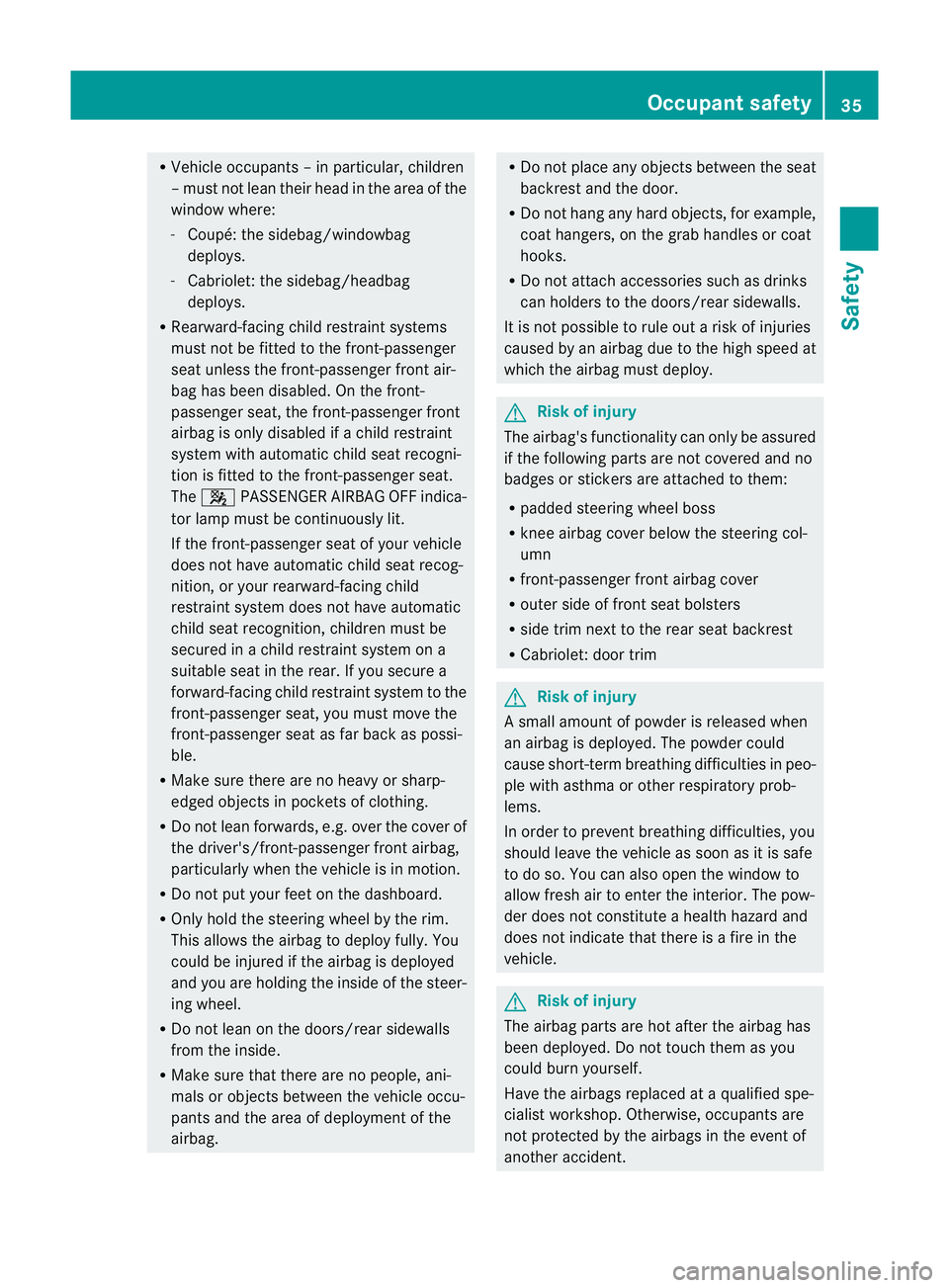
R
Vehicl eoccupant s–inparticular ,children
–m ust not lean their head in the area of the
window where:
- Coupé: the sidebag/windowbag
deploys.
- Cabriolet: the sidebag/headbag
deploys.
R Rearward-facin gchild rest raint systems
must not be fitted to the front-passenger
seat unless the front-passenger fron tair-
bag has been disabled. On the front-
passenger seat, the front-passenger front
airbag is onl ydisabled if achild restraint
system with automatic chil dseat recogni-
tion is fitted to the front-passenger seat.
The 4 PASSENGER AIRBA GOFF indica-
tor lamp must be continuou slyl it.
If the front-passenge rseat of your vehicle
does not have automati cchild seat recog-
nition, or your rearward-facin gchild
rest raint system does not have automatic
child seat recognition, children must be
secured in achild rest raint system on a
suitable seat in the rear. If you secure a
forward-facin gchild rest raint system to the
front-passenger seat, you must move the
front-passenger seat as far back as possi-
ble.
R Make sure there are no heavy or sharp-
edged objects in pockets of clothing.
R Do not lean forwards, e.g. over the cover of
the driver's/front-passenger fron tairbag,
particularly when the vehicle is in motion.
R Do not put your feet on the dashboard.
R Only hold the steerin gwheel by the rim.
This allow sthe airbag to deploy fully. You
coul dbei njured if the airbag is deployed
and you are holding the inside of the steer-
ing wheel.
R Do not lean on the doors/rear sidewalls
from the inside.
R Make sure that there are no people, ani-
mals or obje ctsb etween the vehicle occu-
pants and the area of deployment of the
airbag. R
Do not place any objects between the seat
back rest and the door.
R Do not hang any har dobjects, for example,
coat hangers, on the grab handles or coat
hooks.
R Do not atta chaccessories such as drinks
can holders to the doors/rear sidewalls.
It is not possible to rule out arisk of injuries
caused by an airbag due to the high speed at
which the airbag must deploy. G
Risk of injury
The airbag' sfunctionality can only be assured
if the following parts are not covered and no
badge sorstickers are attached to them:
R padded steerin gwheel boss
R knee airbag cover below the steerin gcol-
umn
R front-passenger fron tairbag cover
R outer side of fron tseat bolsters
R side tri mnexttot he rea rseat back rest
R Cabriolet :door trim G
Risk of inju
ry
As mall amo untofp owder is released when
an air bagisd eployed. The powder could
cause short-term breathing difficulties in peo-
ple with asthma or other respirator yprob-
lems.
In order to prevent bre athing difficulties ,you
should leave the vehicle as soon as it is safe
to do so. You can also open the window to
allow fresh air to enter the interior .The pow-
der does not constitute ahealth hazar dand
doe snot indicat ethat ther eisaf ire in the
vehicle. G
Risk of injury
The airbag parts are hot after the airbag has
been deployed. Do not touch them as you
could burn yourself.
Have the airbags replaced at aqualified spe-
cialist workshop .Otherwise, occupants are
not protected by the airbags in the event of
another accident. Occupant safety
35Safety
BA 207 ECE ÄJ 2010/1a; 1; 2, en-GB
mkalafa Version:3.0.2.11
2010-01-26T13:03:22+01:00
-Seite 35 Z
Page 39 of 333
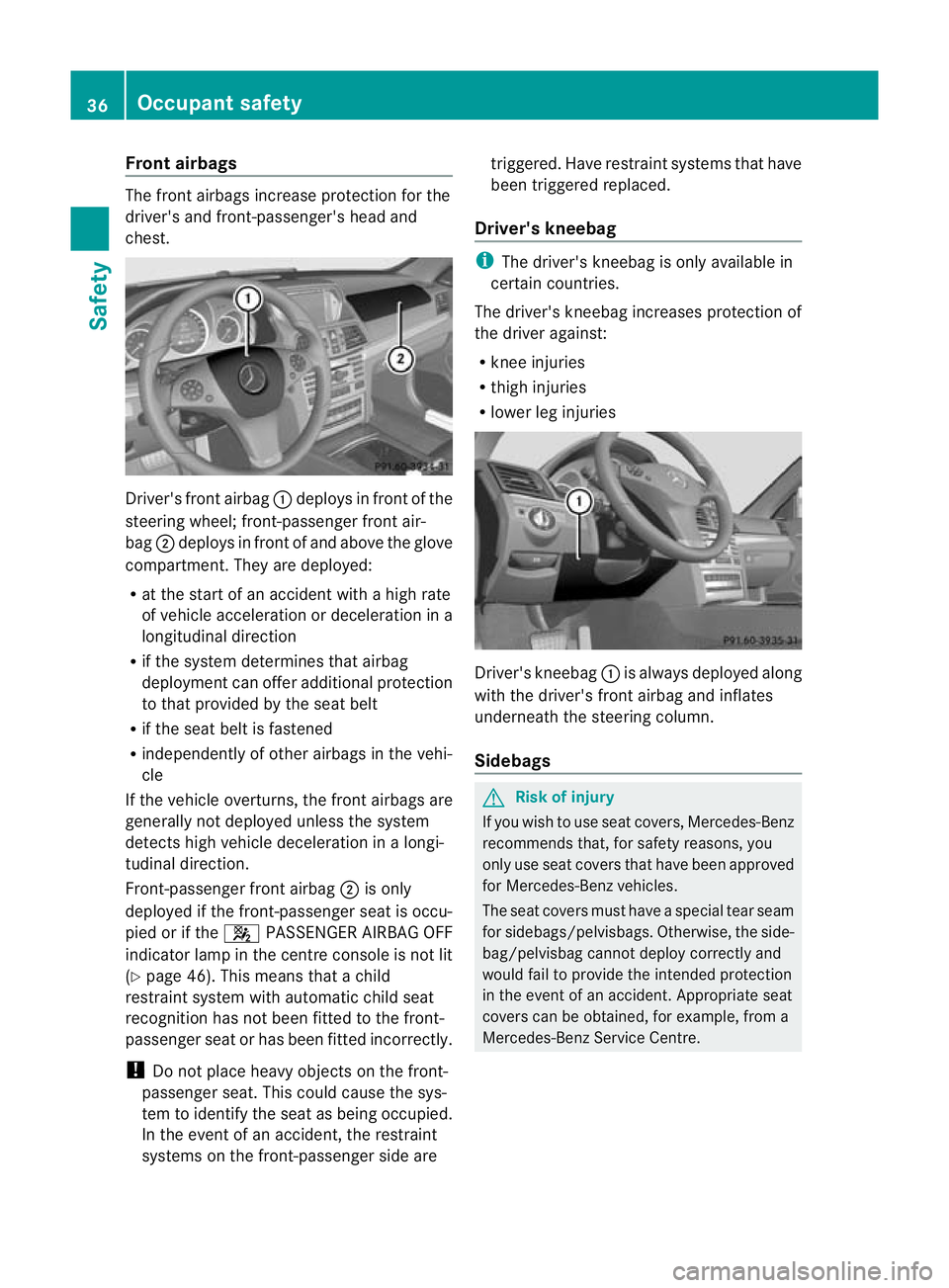
Fron
tairbags The fron
tairbags increase protection for the
driver' sand front-passenger' shead and
chest. Driver
's front air bag:deploys in front of the
steerin gwheel; front-passenger front air-
bag ;deploys in front of and above the glove
compartment .They ar edeployed:
R at the star tofanaccident with ahigh rate
of vehicle acceleration or deceleration in a
longitudinal dire ction
R if the system determines that airbag
deploymen tcan offer additional protec tion
to that provide dbytheseat belt
R if th eseat belt is fastened
R independently of other airbag sinthe vehi-
cle
If the vehicle overturns ,the front airbags are
generally not deployed unless the system
detec tshigh vehicle deceleration in alongi-
tudinal direction.
Front-passenger front airbag ;is only
deployed if the front-passenger seat is occu-
pied or if the 4PASSENGER AIRBA GOFF
indicato rlamp in the centre console is not lit
(Y page 46). This means that achild
restraint system with automatic chil dseat
recognition has not been fitted to the front-
passenger seat or has been fitted incorrectly.
! Do not place heavy object sonthe front-
passenger seat. This could cause the sys-
tem to identify the seat as being occupied.
In the even tofanaccident, the restraint
systems on the front-passenger sid eare triggered
.Have restraint systems that have
been triggered replaced.
Driver's kneebag i
The driver' skneebag is only available in
certain countries.
The driver's kneebag increases protection of
the driver against:
R knee injuries
R thig hinjuries
R lowe rleg injuries Driver's kneebag
:is always deployed along
with the driver' sfront airbag and inflates
underneath th esteering column.
Sidebags G
Risk of injury
If you wish to use seat covers, Mercedes-Benz
recommends that, for safety reasons ,you
only use seat covers that have been approved
for Mercedes-Ben zvehicles.
The seat cover smust have aspecial tear seam
for sidebags/pelvisbags. Otherwise, the side-
bag/pelvisbag cannot deploy correctly and
would fail to provide the intended protection
in the event of an accident. Appropriate seat
cover scan be obtained, for example, from a
Mercedes-Benz Service Centre. 36
Occupant safetySafety
BA 207 ECE ÄJ 201
0/1a; 1; 2, en-GB
mkalafa Version: 3.0.2.11 2010-01-26T13:03:22+01:00-Seite 36
Page 43 of 333

Resetting trig
geredN ECK-PR Ohead
restraints
Mercedes-Ben zrecom mends that you have
NECK-PRO hea drestraint schecked at aquali-
fied specialist workshop, e.g. aMercedes-
Ben zService Cent re,followin garear-en dcol-
lision.
i Resetting the NECK -PRO head restraints
requires alot of strength. If you have diffi-
culty resettin gthe NECK -PRO head
restraints, have this work carried out at a
qualified specialist workshop, e.g. a
Mercedes-Benz Service Centre. Example: Coupé
X
Tilt the top of the NECK-PRO head restraint
cushio nforwards in the direction of
arrow :.
X Push the NECK -PRO head restraint cushion
down as far as it will go in the direction of
arrow ;.
X Firmly push the NECK-PRO head restraint
cushio nbackwards in the direction of
arrow =until it engages.
X Repeat this procedure for the second
NECK -PRO head restraint. Seat belts
Important safet ynotes Seat belts are the most effective means of
restrainin gthe movemen tofvehicle occu-
pant sint he even tofanaccide nt.T his reduce
sthe risk of vehicle occupants coming
int oc ontac twith parts of the vehicle interior. G
Risk of injury
As eat belt which is not worn cor rectly, or
which has not bee nengaged in the sea tbelt
buckle cor rectly, cannot perform its intended
prote ctive function .Under certain circum-
stances, this could cause severe or even fatal
injuries in the event of an accident.
Make sure that all occupants –inparticular,
pregnan twome n–w ear their seat belt cor-
rectly at all times.
R The seat belt must fit snugly on your body
and must no tbetwisted. Therefore, you
should avoid wearing bulky clothin g(e.g. a
winter coat) .The shoulder belt section
must be routed across the cen treofy our
shoulder –onnoaccount acros syour neck
or under your arm –and pulled tight against
your uppe rbody. The lap belt must always
pass across your lap as low down as possi-
ble, i.e. over your hip join ts–n ot across
your abdomen. If necessary ,push down the
belt strap slightly and then retighten it in
the roll-up direction.
R Do not route the belt strap across sharp
edge sorfragil eobjects, especially if these
are located on or in your clothing, e.g. spec-
tacles, pens, keys, etc. The seat belt strap
could be damaged and tear in an accident,
and you or other vehicl eoccupants could
be injured.
R Onl yone person should use each sea tbelt
at any one time. Children must never travel
sittin gont he lap of other occupan ts.It
would not be possible to restrain the child
in the event of asudden change in direc-
tion, braking or an accident .This could
result in sever eoreven fata linjuries to the
child and othe roccupants.
R Persons les sthan 1.50 mtall cannot wear
the seat belts correctly. For this reason,
secure persons less than 1.50 mtall in spe-
cially designed, suitable restraint systems. 40
Occupant safetySafety
BA 20
7ECE ÄJ 2010/1a; 1; 2, en-GB
mkalafa Version: 3.0.2.11 2010-01-26T13:03:22+01:00-Seite 40
Page 44 of 333

R
Children less than 1.50 mtall or under 12
years of age cannot wear the seat belts
properly. Therefore, they always should be
secured in asuitable child restraint system
on asuitable vehicle seat. You can find
more information under "Children in the
vehicle" in the "Safety" section of the Own-
er's Manual. Follow the manufac turer's
installatio ninstructions whe nfitting the
child restraint system.
R Do not secure any objects with aseat belt
if the seat belt is also being used by one of
the vehicle's occupants. G
Risk of injury
The seat belt does not offer the intended level
of protection unless the back rest is almost
ver tical. Under certain circumstances, this
coul dcause severe or even fatal injuries in the
event of an accident.
Befor estarting ajourney, mak esure that the
seat is properly adjusted and that the back-
rest is almost vertical. G
Risk of injury
Ad irtyo rdamaged seat belt or aseat belt that
has been subjected to aload in an accident
or which has been modified no longer offers
the intended level of protection. Un dercertain
cir cumstances, this could caus esever eor
even fatal injuries in the even tofanaccident.
For thi sreason, check regularly that the seat
belts are not damaged or dirty.
Alway shaved am aged sea tbelts or seat belts
that have been subjected to aload in an acci-
dent replaced at aqualified specialist work-
shop. Consult aqualified specialist workshop
which has the necessary specialist knowledge
and tools to carry out the work required.
Mercedes -Benz recommends that you use a
Mercedes-Benz Ser vice Centre for thi spur-
pose.
For safety reasons, Mercedes -Benz recom-
mends that you only use seat belts which have
been approved by Mercedes-Benz for your
vehicle. Fastening seat belts The seat-belt extender for the driver and front
passenger helps you fasten your seat belt.
Example: Coupé
Seat-belt extender
:is extended when the
respective door is closed and the key is
tur nedtop osition 1or 2in the ignition lock.
You can also activa teseat -belt extender :
by using the seat-belt extender button in the
centre console. X
Press the seat-belt extender button.
Seat -belt extender :extends. G
Risk of inju
ry
The seat-belt extender must be ret racted
whe nthe vehicle is in motion .Only then can
the sea tbelt fit properly on the body and per-
for mi ts protective function.
Seat-belt extender :is retracted again if:
R the belt tongue is engaged in the sea tbelt
buckle.
R the belt tongue is not engaged in the seat
belt buckle within 60 seconds. Occupant safety
41Safety
BA 207ECE ÄJ 2010/1a; 1; 2, en-GB
mkalafa Version: 3.0.2.11 2010-01-26T13:03:22+01:00-Seite 41 Z
Page 47 of 333
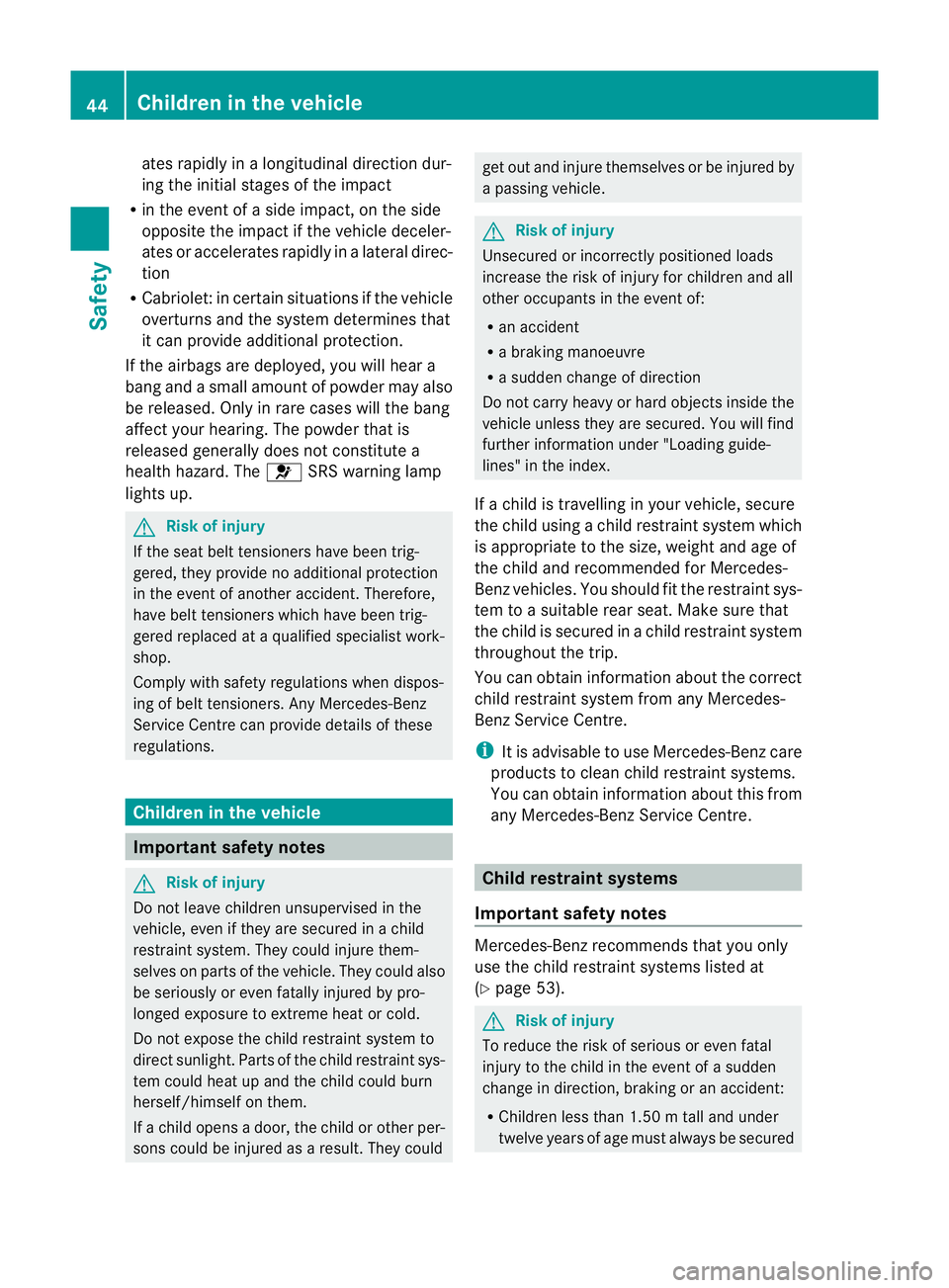
ates rapidly in
alongitudinal dir ectiondur-
ing the initial stages of the impact
R in the even tofaside impact, on th eside
opposit ethe im pactift he vehicle deceler-
ates or accelerates rapidly in alateral direc-
tion
R Cabriolet: in certain situations if the vehicle
overturns and the system determines that
it can provide additional protection.
If the airbags are deplo yed,you will hear a
bang and asmall amount of powder may also
be released. Only in rare cases will th ebang
affect your hearing. The powde rthat is
released generally does not constitute a
healt hhazard. The 6SRS warning lamp
lights up. G
Risk of injury
If the seat belt tensioners have been trig-
gered, they provide no additional protection
in the event of another accident. Therefore,
have belt tensioners which have been trig-
gered replaced at aqualified specialist work-
shop.
Comply with safety regulations when dispos-
ing of belt tensione rs.A ny Mercedes-Be nz
Service Centre can provid edetails of these
regulations. Children in the vehicle
Impor
tantsafety notes G
Ris
kofi njury
Do not leav echildren unsupervised in the
vehicle, even if they ar esecured in achild
restraint system .They coul dinjure them-
selves on parts of the vehicle. The ycould also
be seriously or even fatally injure dbypro-
longe dexposure to extreme hea torcold.
Do not expose the child restraint system to
direct sunlight. Part softhe chil drestraint sys-
tem could heat up and the child could burn
herself/himself on them.
If ac hild opens adoor, the child or other per-
sons coul dbeinjured as aresult. They could get out and injure themselves or be injured by
ap
assing vehicle. G
Risk of injury
Unsecured or incorrectly positioned loads
increase the risk of injury for children and all
other occupants in the event of:
R an accident
R ab raking manoeuvre
R as udden change of direction
Do not carry heavy or hard objects inside the
vehicle unless they are secured. You will find
further information under "Loading guide-
lines" in the index.
If ac hild is travellin ginyour vehicle, secure
the child using achild restraint system which
is appropriate to the size, weight and age of
the chil dand recommended for Mercedes-
Benz vehicles. You should fit the restraint sys-
tem to asuitable rear seat. Make sure that
the child is secured in achild restraint system
throughout the trip.
You can obtai ninformation abou tthe correct
chil drestraint system from any Mercedes-
Benz Servic eCentre.
i It is advisable to use Mercedes-Ben zcare
product stocleanc hildr estraint systems.
You can obtain informatio nabout this from
any Mercedes-Benz Ser vice Centre. Chil
drestraint systems
Importan tsafety notes Mercedes-Benz reco
mmends that you only
use the child restraint system slisted at
(Y page 53). G
Risk of injury
To reduce the risk of serious or even fatal
injury to the child in the event of asudden
change in direction, brakin goranaccident:
R Children less than 1.5 0mtall and under
twelv eyears of age must alway sbesecured 44
Children in th
evehicleSafety
BA 20 7ECE ÄJ 2010/1a; 1; 2, en-GB
mkalafa Version: 3.0.2.11 2010-01-26T13:03:22+01:00-Seite 44